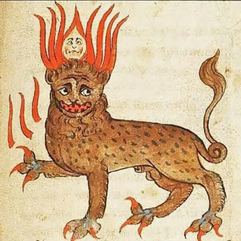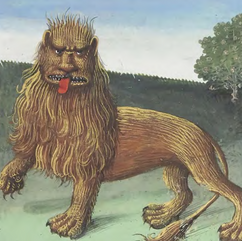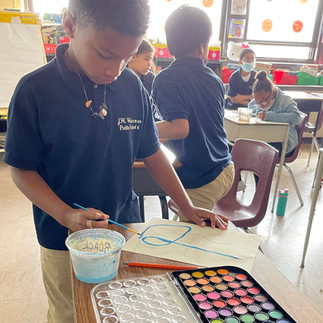Magic in the Making
- frida@artyardbklyn.org

- May 27, 2022
- 6 min read
This week Teaching Artist Jane Huntington presented a session titled The Hunt of the Unicorn and Other Magical Beasts at ART YARD Advanced Studio on Zoom. Inspired by The Unicorn Tapestries and medieval artworks of animals, we drew from a written description of rare and unusual animals.
Jane summarizes: “I begin the lesson talking about the Hunt of the Unicorn Tapestries, located at the Cloisters museum. I discussed many themes–the unicorn’s story as an allegory of Christ, the 105 different species of plants, it’s flat pre-renaissance perspective, and all of the animals depicted. At the end of this section, I pointed out strange images of lions found in the Unicorn Tapestries.

It was assumed that the reason that the lions looked so weird was because artists relied heavily on written and oral descriptions, in fact, there were many lions already in Europe starting in the 13th century. Artists were often breaking with nature to express an idea. Rather than mistakes, these definitely un-lion-like specimens can be viewed as artistic decisions, albeit ones which appear delightfully strange to our modern eyes.
Medieval depictions of lions
For the session I asked participants to use the materials of their choice to depict an actual (but likely unfamiliar) animal from a written descriptions which I sent each of them through the chat feature on Zoom. I specifically asked them not to look up an image of their animal!
Assata’s silky haired four stomached monkey is beautifully rendered.

Karla’s media collage depicts a helmeted bird in the center tondo, ringed by a drawing which calls to mind the multitudinous flora of the Unicorn Tapestries.

Kevin and Zeke focus on their keen drawing skills in their renderings.
Kevin Anderson, Other Magical But Real Beasts and Zeke Brokaw, Other Magical But Real Beasts
Robin and Alison both did a stunning drawings using Craypas.
Robin Grant, Other Magical But Real Beasts and Alison Guinet, Other Magical But Real Beasts
Delphine drew two interpretations based on what she felt when reading the description.
Delphine Levenson, Other Magical But Real Beasts
Meridith did a watercolor of a Jellyfish with 99 tentacles and a red stomach.

Marilyn was fanciful in her watercolor of two monkeys adding jester-like neckwear.

Ed drew a comical version of the frilled neck lizard.”

So as not to see a depiction of the animal she was to draw, Jane generated an animal description from an on-line app. We decided during critique that her beast must have been imaginary, but that in no way detracted from her gorgeous line drawing!

Tuesday morning Dennis and I met to plan and strategize upcoming ART YARD programs, proposals and new possibilities. Then Dennis walked over to BNS and I went to get copies for our animation session at BWAC.
Teaching Artist Evelyn Beliveau reports: “Students were energetic and industrious at ART YARD Art Matters at BNS this week!
One group of students continued with the detail work on their stained-glass-inspired collages. Olivia's waterfall piece (featuring paper beautifully custom-colored with watercolors) is shaping up well, as is Nathaly's meticulous composition of pink slips of paper on the black background. Pops of color abound in both Akil and Mark's pieces, and Lucas's field of stars and meteors wowed his peers at critique.


The rest of the class dove into week two of Fantastical Tree Houses. Some students made drawings, such as Charlie's crystal tree and Bear's reprise of his tech-room treehouse. Then, everyone jumped into the first stages of making paper tree sculptures. Students paid close attention to the step by step process for constructing the base and trunk--they designed the bark of the tree with colored pencils, followed several steps of folding, cutting, and taping to create a stable base, and attached the cylindrical trunk using notches cut into the paper. Some steps were challenging, and students used their problem-solving skills to achieve a sufficiently stable upright structure. Some students reached the stage of adding roots and branches, and we'll pick up there next week!
Later that evening at ART YARD Advanced Studio in person at BWAC Teaching Artist Damian Quiñones was back present the second in his two part series on basic stop motion and cell animation using smart phone devices.

We jerry-rigged music stands and other devices to hold our phones as we animated out work from last week using the smartphone/tablet apps. First taking images with Stop Motion Studio as we cut, drew, moved our actors (objects or items we depicted). Then we transferred the video into Videoleap editor to add effects.
Nayarit, who missed the session last week, caught up with the rest of us by using architectural images from magazines she had in her bag.
Please click to activate the animations!
Nayarit Tineo, Animation
Evelyn and I both continued to work on our pieces, Evelyn even created a second animation of a painting!
Evelyn Beliveau, Animation Stills I & II, and Meridith McNeal, Animation Still:
Evelyn Beliveau, Animation I
Evelyn Beliveau, Animation II
Meridith McNeal, Animation
Damian explains: “The second of my two classes went very well. The participants created imaginative pieces from last weeks art making session that we complied into a longer piece and projected onto a screen. We then discussed what we would add or modify given more time.”

Alison Guinet, Animation
Damian compiled a group video which he then projected for critique.

Ed Rath, Psycho Pumpkin Animation

Damian Quiñones, Animation
Roving (actually, rolling) from classroom to classroom, Dennis and teaching artist Evelyn Beliveau delved further into Hilma af Klint's abstract paintings and their symbolisms at ART YARD Art Matters at PS 6.
Managing Director Dennis Buonagura reports: “We travelled with containers of water, brushes, watercolor paint tins, pencils, and watercolor paper to help students move up to their next steps. Each student was asked to create a new design (or use last week's design) on watercolor paper (using pencil) to depict a cycle (and there were various ideas for cycles!) in an abstract form.
Evelyn showed more images of Hilma af Klint's work, primarily her Swan Series - which opened up a vibrant discussion about what Hilma might have been thinking and how the viewers see the series relative to swans (ie: swirly lines, wing-like formations, black circles and white circles, triangles). Additionally, Evelyn's presentation included some photographs of Hilma - and all students agreed that Hilma had NOT taken them as selfies using an iPhone (not even an iPhone series 1).


Evelyn demonstrated watercolor painting techniques and worked closely with those students who hadn't painted with watercolors before.
Emmanuel created an abstract of the construction cycle of a propeller plane; Nicholas worked diligently - carefully choosing colors - and painted with very straight lines. His work is an abstraction of a sailboat, quite Hilma af Klint-esque at that! Corey's seems almost fish-like but purely an abstract with great color mixing.



Students chose to work in small groups - still following the school's pandemic protocol; they got as close as allowed, stretching arms to reach the paints and water. Teamwork always produces excellent results.

Critiques are always lively at PS 6 - mostly because students are well versed in 'compare and contrast' as evidenced by posters hanging in their classrooms. As a result, we have great participation in that segment of our critique curriculum.”

During their break, Evelyn and Dennis deinstalled the exhibit hanging in the gallery in anticipation of an upcoming exhibit - whether live or remote. It's all yet to be determined.
Other Art News
ART YARD Artist Karla Prickett shares: “I am serving as project assistant to David Loewenstein whose work is steeped in the history of community mural processes. Salina, Kansas Community members participated in a workshop centered around questions related to participants’ movement in daily routines…where they live, where they attend events, where they dine, etc. each mapped their routines on a large historic Salina map with push pins. Then they connected their pins with colored threads. The mural design was inspired by this hands-on activity and reflects the way individuals cross paths with one another and our connectedness! It’s about place.
I (Karla) led a project of Dave’s over ten years ago and a beautiful mural of his was torn down due to developers’ preferences for renovation. It poses an interesting set of questions related to the temporary or permanent nature of art in public spaces. Also creates an interesting dynamic between privately funded projects and public art program projects. Seems private funding leaves many gaps as to quality or content related to “place.” Happy Dave was offered another wall and project through the Arts and Humanities. He has been painting murals for over 40 years!"

There you have it, another magical week at ART YARD!
🔮💜

























































Comments